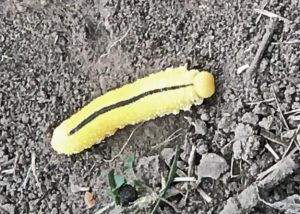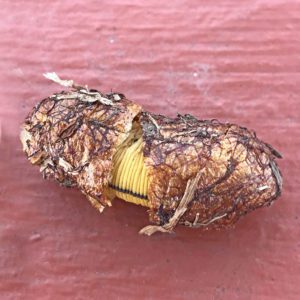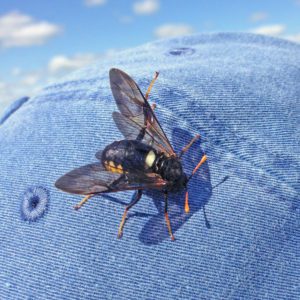Howdy, BugFans,
The BugLady got a few “what’s this dynamite caterpillar?” pictures from a friend toward the end of summer – one of a larva, and one of a pupal case in not-very-good shape. She usually gets “what’s this wasp/fly?” pictures of the equally-distinctive adult in June, like this one from BugFan Andy.
Sawflies are small, primitive wasps (ancestral sawflies were around 250 million years ago) that most people have never heard of, and they usually carry out their business below the radar. They’re in the large order Hymenoptera (ants, bees, wasps, and sawflies) and in the family Cimbicidae, which includes about 200 species (12 in North America). Cimbicids lack that famous “wasp waist,” have prominently knobbed antennae, and some of the heftier species can be mistaken for hornets https://bugguide.net/node/view/1544361/bgimage. Their larvae resemble moth or butterfly caterpillars until you compare eyes (sawflies have fewer) or count legs (sawflies have more). There have been a number of previous episodes about sawflies – here are two of them: https://uwm.edu/field-station/sawflies-among-us/ and https://uwm.edu/field-station/slug-sawfly-a-skeletonizer/.
With ¾” adults and 2” larvae, the Elm sawfly (Cimbex americana) is the largest (or “among the largest,” depending on who you read) sawfly in North America. The (usually) blue-black adults are sexually dimorphic (“two forms”). Females have thickened femurs on the second and third pair of legs, and they usually have pale, wrap-around stripes on the abdomen that don’t quite touch at the midline https://bugguide.net/node/view/610402/bgimage. Males’ legs are massive https://bugguide.net/node/view/1099589/bgimage, and they may have a red or black abdomen. Both have smoky wings, orange antennae, and a white spot at the base of the thorax.
As Eric Eaton says in his bugeric blog, “They do not have a stinger. Both genders simply look intimidating” http://bugeric.blogspot.com/2012/06/wasp-wednesday-elm-sawfly.html.
The pebbly-textured larvae come in a rainbow of colors: https://bugguide.net/node/view/1724940/bgimage, https://bugguide.net/node/view/1495194/bgimage, https://bugguide.net/node/view/1421517/bgimage, https://bugguide.net/node/view/1525493/bgimage, and,
rarely, pink https://bugguide.net/node/view/708165/bgimage,
with a creepy-looking head https://bugguide.net/node/view/1700150/bgimage that looks like something that the BugLady saw in an X Files episode.
These amazing larvae are chemically defended – glands near the spiracles (breathing pores along the sides of the body) produce unwholesome liquids that can be released through the pores.
The “saw” in sawfly comes from the female’s egg laying apparatus, which she uses to make a hole in the underside of a leaf (or twig, say some sources) in late spring. She may deposit several eggs on one leaf, and she can lay more than 125 of them, total. True to her name, elm is the main host plant, but she also oviposits on willow (another favorite), and incidentally on maple, birch, willow, basswood, cottonwood, poplars, ironwood, plum, alder, boxelder, and apple. The larvae eat their host’s leaves, wrapping their rear half around twigs while feeding https://bugguide.net/node/view/1716690/bgimage (and curling up tightly at rest https://bugguide.net/node/view/1006040/bgimage). When they’re almost-mature, they drop to the ground to make a pupal case in the leaf litter, and they complete their metamorphosis in spring https://bugguide.net/node/view/931802/bgimage. Or they may decide to stay tucked inside their cocoon until the following spring.
They are vegetarians as larvae and adults. Adults have sturdy jaws that they use to pierce and even girdle the bark of twigs so they can feed on the sap. Larvae are attacked by a number of parasites/parasitoids, and larvae and pupae are eaten by mice and shrews. Populations can be somewhat cyclical, and the larvae may be minor forest pests in peak years, but harm is minimized because they’re feeding late in a tree’s growing season.
Kate Redmond, The BugLady
Bug of the Week archives:
http://uwm.edu/field-station/category/bug-of-the-week/



